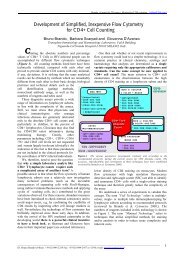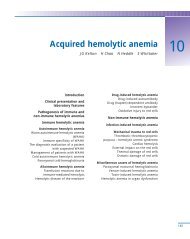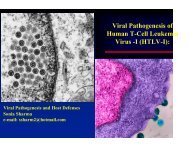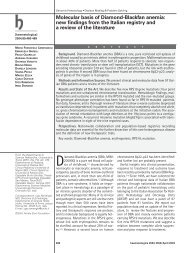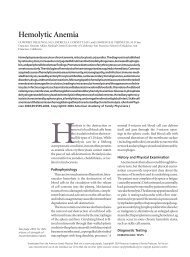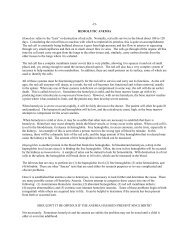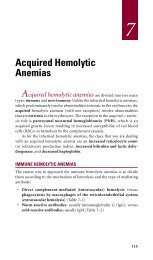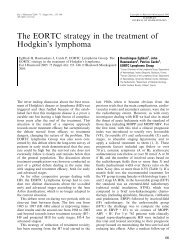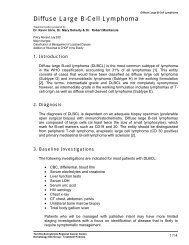Procarbazine in haematology: an old drug with a new life?
Procarbazine in haematology: an old drug with a new life?
Procarbazine in haematology: an old drug with a new life?
Create successful ePaper yourself
Turn your PDF publications into a flip-book with our unique Google optimized e-Paper software.
M. Massoud et al. / Europe<strong>an</strong> Journal of C<strong>an</strong>cer 40 (2004) 1924–1927 1925<br />
<strong>an</strong>d time elapsed after treatment, suggest<strong>in</strong>g that the<br />
breaks occur dur<strong>in</strong>g or soon after DNA synthesis [7].<br />
In addition to these effects on nuclear DNA, PCB c<strong>an</strong><br />
<strong>in</strong>hibit DNA, RNA <strong>an</strong>d prote<strong>in</strong> synthesis [6]. Inhibition<br />
of prote<strong>in</strong> synthesis is delayed <strong>an</strong>d c<strong>an</strong> only be a late<br />
effect due to the <strong>in</strong>hibition of nucleic acid synthesis.<br />
Recent data suggest that PCB cytotoxicity is ma<strong>in</strong>ly<br />
mediated by its methylat<strong>in</strong>g properties. Dur<strong>in</strong>g PCB<br />
treatment, the generation of large amounts of 6 O-<br />
methylgu<strong>an</strong><strong>in</strong>e (also known as a mutagenic <strong>an</strong>d carc<strong>in</strong>ogenic<br />
agent) could contribute to PCB cytotoxicity<br />
[8–10]. Delays <strong>in</strong> the growth of tumours lack<strong>in</strong>g AGT<br />
(the enzyme mediat<strong>in</strong>g 6 O-methylgu<strong>an</strong><strong>in</strong>e repair) were<br />
observed follow<strong>in</strong>g the adm<strong>in</strong>istration of PCB to thymic<br />
nude mice bear<strong>in</strong>g xenografts derived from hum<strong>an</strong> malign<strong>an</strong>t<br />
gliomas <strong>an</strong>d medulloblastomas, compared <strong>with</strong><br />
mice <strong>with</strong> normal AGT activity, emphasis<strong>in</strong>g the import<strong>an</strong>ce<br />
of this methylat<strong>in</strong>g pathway <strong>in</strong> PCB <strong>an</strong>tic<strong>an</strong>cer<br />
activity [11].<br />
3. Drug resist<strong>an</strong>ce <strong>an</strong>d cl<strong>in</strong>ical pharmacology<br />
Recently, mech<strong>an</strong>isms of resist<strong>an</strong>ce to PCB have also<br />
suggested that the methylat<strong>in</strong>g activity of PCB plays a<br />
key role <strong>in</strong> its cellular toxicity. Resist<strong>an</strong>ce to PCB c<strong>an</strong><br />
develop rapidly <strong>in</strong> tumour cells. The above-mentioned<br />
relationship between PCB <strong>an</strong>d AGT activities suggests<br />
that resist<strong>an</strong>ce to this agent could be secondary to AGTmediated<br />
repair of 6 O-methylgu<strong>an</strong><strong>in</strong>e activity <strong>an</strong>d this is<br />
similar to resist<strong>an</strong>ce to nitrosourea which is also mediated<br />
by this enzyme [12]. Other <strong>drug</strong>-resist<strong>an</strong>ce mech<strong>an</strong>isms,<br />
such as hMSH2 mismatch-repair deficiency, have<br />
recently been identified <strong>in</strong> PCB <strong>drug</strong>-resist<strong>an</strong>ce [13–15].<br />
The recent identification of these <strong>drug</strong>-resist<strong>an</strong>ce mech<strong>an</strong>isms<br />
could be <strong>in</strong>strumental <strong>in</strong> the development of <strong>new</strong><br />
therapeutic strategies <strong>with</strong> PCB. Modulation of AGT<br />
activity has already been <strong>in</strong>vestigated.<br />
The pharmacok<strong>in</strong>etics <strong>an</strong>d metabolism of PCB have<br />
been studied mostly <strong>in</strong> laboratory <strong>an</strong>imals, <strong>an</strong>d such<br />
<strong>in</strong>formation <strong>in</strong> hum<strong>an</strong>s is <strong>in</strong>complete. The rapid <strong>an</strong>d<br />
extensive enzymatic metabolism of PCB plays a role <strong>in</strong><br />
the complexity of its pharmacok<strong>in</strong>etic <strong>an</strong>d excretion<br />
characteristics. PCB hydrochloride is available <strong>in</strong> 50 mg<br />
capsules. In HLs, it is usually given at a daily dose of<br />
100 mg/m 2 for 7–14 days [16]. After oral adm<strong>in</strong>istration,<br />
the <strong>drug</strong> is rapidly <strong>an</strong>d completely absorbed from the<br />
gastro<strong>in</strong>test<strong>in</strong>al tract. The biodistribution of PCB is not<br />
well known, but there is rapid equilibration of PCB<br />
between plasma <strong>an</strong>d cerebrosp<strong>in</strong>al fluid <strong>in</strong> hum<strong>an</strong>s. PCB<br />
treatment is able to alter its own metabolism: the total<br />
<strong>an</strong>d relative plasma concentrations of PCB metabolites<br />
were ch<strong>an</strong>ged after the adm<strong>in</strong>istration of 14 daily oral<br />
doses. There is a signific<strong>an</strong>t <strong>in</strong>crease <strong>in</strong> the azoPCB<br />
concentration over time, suggest<strong>in</strong>g that prior exposure<br />
to PCB <strong>in</strong>duces the production of this metabolite or<br />
delays its clear<strong>an</strong>ce. The major ur<strong>in</strong>ary metabolite is the<br />
biologically <strong>in</strong>active N-isopropylterephtamilic acid (70%<br />
of the <strong>drug</strong> dur<strong>in</strong>g the first 24 h). There is m<strong>in</strong>imal faecal<br />
<strong>an</strong>d respiratory excretion of the <strong>drug</strong> (from 4% to 12%<br />
<strong>an</strong>d 20% to 30%, respectively).<br />
4. Toxicity <strong>an</strong>d <strong>drug</strong> <strong>in</strong>teractions<br />
Long-term PCB toxicities rema<strong>in</strong>ed a major problem<br />
<strong>an</strong>d were responsible for the <strong>with</strong>drawal of PCB from<br />
recent comb<strong>in</strong>ation chemotherapy regimens, for example,<br />
ABVD <strong>in</strong> HLs. However, given the high activity of<br />
PCB <strong>in</strong> this disease, it has recently been re<strong>in</strong>troduced <strong>in</strong><br />
<strong>new</strong> dose-<strong>in</strong>tensified regimens, but at lower doses th<strong>an</strong> <strong>in</strong><br />
the classic mechloretham<strong>in</strong>e, v<strong>in</strong>crist<strong>in</strong>e, PCB, prednisolone<br />
(MOPP) regimen. PCB has profound azoospermic,<br />
teratogenic, mutagenic <strong>an</strong>d carc<strong>in</strong>ogenic effects that<br />
c<strong>an</strong> limit its use <strong>in</strong> hum<strong>an</strong>s [17–20].<br />
Rare side-effects, usually observed when large cohorts<br />
of patients are treated <strong>with</strong> a <strong>drug</strong>, have also been reported<br />
<strong>in</strong> recent decades: haemolysis <strong>in</strong> <strong>in</strong>dividuals <strong>with</strong><br />
glucose 6-phosphate dehydrogenase deficiency; hypersensitivity<br />
reactions, <strong>in</strong>clud<strong>in</strong>g maculo-papular sk<strong>in</strong><br />
rash, eos<strong>in</strong>ophilia, pulmonary <strong>in</strong>filtrates, or, rarely,<br />
tr<strong>an</strong>sient hepatic dysfunction. PCB pulmonary toxicity<br />
necessitates discont<strong>in</strong>uation of the <strong>drug</strong> [21–23].<br />
M<strong>an</strong>y <strong>drug</strong>–<strong>drug</strong> or <strong>drug</strong>–food <strong>in</strong>teractions are observed<br />
<strong>with</strong> PCB because of its extensive hepatic microsomal<br />
metabolism <strong>an</strong>d its capacity to <strong>in</strong>hibit monoam<strong>in</strong>e<br />
oxidase. Patients tak<strong>in</strong>g barbiturates, phenothiaz<strong>in</strong>es,<br />
narcotics, <strong>an</strong>d hypnotics or sedatives may experience<br />
potentiated effects of these <strong>drug</strong>s dur<strong>in</strong>g PCB therapy.<br />
Other <strong>drug</strong>s such as cimetid<strong>in</strong>e or phenobarbital (pretreatment<br />
<strong>with</strong> phenobarbital results <strong>in</strong> <strong>in</strong>creased PCB<br />
clear<strong>an</strong>ce) c<strong>an</strong> affect PCB hepatic metabolism.<br />
The <strong>in</strong>hibition of monoam<strong>in</strong>e oxidase also predisposes<br />
patients to acute hypertensive reactions after<br />
concomit<strong>an</strong>t therapy <strong>with</strong> tricyclic <strong>an</strong>tidepress<strong>an</strong>ts <strong>an</strong>d<br />
sympathomimetic <strong>drug</strong>s, as well as after <strong>in</strong>gestion of<br />
tyram<strong>in</strong>e-rich beverages or foods, such as red w<strong>in</strong>e,<br />
b<strong>an</strong><strong>an</strong>as, ripe cheese <strong>an</strong>d yogurt. After <strong>in</strong>gestion of alcohol,<br />
disulfiram-like reactions (sweat<strong>in</strong>g, facial flush<strong>in</strong>g<br />
<strong>an</strong>d headache) may occur.<br />
5. PCB <strong>in</strong> Hodgk<strong>in</strong>’s lymphoma therapy<br />
The development of cytotoxic <strong>drug</strong>s <strong>in</strong> the early 1960s<br />
dramatically improved the survival of patients <strong>with</strong> adv<strong>an</strong>ced<br />
HL [24]. Nitrogen mustard, PCB, v<strong>in</strong>crist<strong>in</strong>e <strong>an</strong>d<br />
prednisolone were shown to be active <strong>in</strong> HL as s<strong>in</strong>gle<br />
agents (see Table 1), but few patients achieved a complete<br />
response [25]. These responses were not long-lived<br />
<strong>an</strong>d cure was not achieved. At the National C<strong>an</strong>cer Institute,<br />
DeVita <strong>an</strong>d co-workers [16] developed a 4-<strong>drug</strong><br />
chemotherapy regimen MOPP which was the first to



